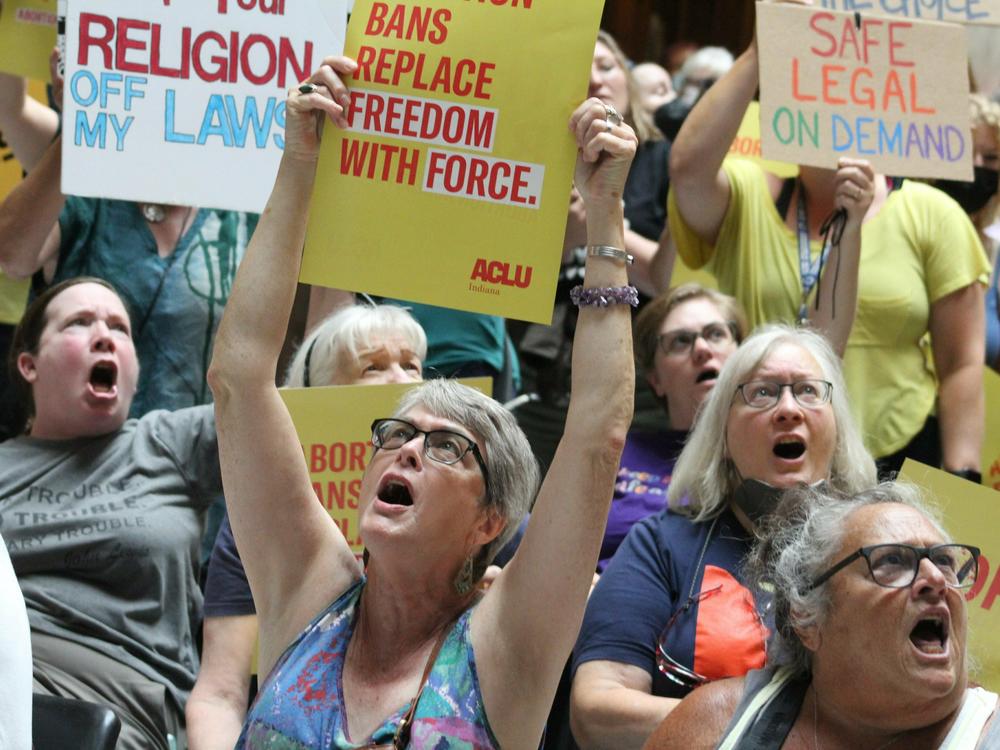Section Branding
Header Content
After yearlong fight, a near-total abortion ban is going into effect in Indiana
Primary Content
A sweeping ban on most abortions is scheduled to take effect today in Indiana. It would prohibit abortions at any point during pregnancy except if the woman's life or health is seriously at risk. Abortion would be permitted before 22 weeks of pregnancy if a "lethal fetal anomaly" is detected, or until 12 weeks of pregnancy in cases of rape or incest.
Late Monday, Planned Parenthood and other abortion providers filed a last-minute legal request with the Indiana Supreme Court, asking the justices to rehear their previous legal challenge. The move may delay the law from taking effect by a few hours or even days, but most expect the Court to certify its original 4-1 ruling, issued June 30, which upheld the law.
At an abortion rights rally over the weekend, Democratic Indianapolis City-County Councilor Ali Brown criticized the looming ban.
"It is a right that I was born with, and on Tuesday, I will wake up without that right, and I find it disgusting and reprehensible that people would put their religious positions over the health and safety of pregnant people," she said.
The restrictions will impact not just Hoosiers but also people in nearby states who have been relying on Indiana as a place where they could still access abortion.
"Any ban on abortion has ripple effects, and it impacts everyone," said Savannah Trebuna of the Kentucky Health Justice Network's Abortion Support Fund. Abortion has been illegal in Kentucky since Aug. 1, 2022.
While lawsuits continued, abortion available up to 22 weeks
Indiana lawmakers approved the new state law last summer on Aug. 5, soon after the U.S. Supreme Court overturned Roe v. Wade in the Dobbs ruling.
The law took effect last September – but only for a week. It was put on hold for almost a year while abortion rights advocates fought the law's constitutionality in state courts.
But the June 30 ruling from the state's highest court meant that Indiana's remaining six clinics would be barred from offering abortions as early as Aug. 1.
During the legal battles, abortion remained legal in Indiana for up to 22 weeks of pregnancy. Abortion rights advocates mourned the pending ban, not just for its impact on residents but for patients across large swaths of the Midwest and South.
"The Indiana ruling ... is not only devastating for Indiana, but for surrounding states – particularly folks living in the South who have made Indiana, of all places, a destination to receive abortion care," said Alison Dreith of the Midwest Access Coalition, which provides financial assistance to people traveling to get an abortion in Midwestern states.
Indiana received patients from Kentucky, Ohio and beyond
While most abortions in Indiana were provided to state residents, data shows almost a fifth of the people who got an abortion there last year came from other states.
The highest number of out-of-state patients, 950, were from neighboring Kentucky. Kentucky's current law only allows abortion if there's a life-threatening risk to the pregnant patient.
People in the Louisville area typically went to Indiana for the procedure, according to Trebuna. Meanwhile, people in Western Kentucky often travel to Illinois for care, and Virginia has become an important access point for residents in Eastern Kentucky.
Then, there is Ohio. A total of 611 women came to Indiana last year from the Buckeye state, despite the fact that abortion remains legal there until about 22 weeks of pregnancy. Ohio lawmakers did pass a six-week abortion ban, but that has been temporarily blocked by the courts. It's possible Ohio could end up seeing that ban reinstated, just like Indiana's.
Where patients go for abortion care depends on various factors, including what clinics are closest geographically and when appointments are available.
Dreith's organization had been helping patients travel to Indiana from as far away as Georgia, Tennessee, and Texas. Indiana's new ban "will increase the stress on the abortion safety net," she said.
As bans increase, access becomes a puzzle of distance, time and money
In the upper Midwest, abortion remains legal in Illinois, Michigan, Minnesota and — for now — Ohio. But at the remaining clinics, capacity can no longer keep up with demand. Patients can wait weeks for an appointment, and that can make the procedure more complicated and expensive.
"We don't want anybody to go without care," said Tamarra Wieder, the Kentucky state director of Planned Parenthood Alliance Advocates, which advocates for abortion rights in six states. "But you know, there are only so many appointments and only so many providers."
Under Indiana's ban, Kentucky residents will lose "their second home for abortion care," Wieder said.
Since Dobbs, abortion has become less accessible across the Midwest. But it's still more available there than it is in the South, where most of the states with near-total abortion bans are located.
Moving forward, Planned Parenthood will keep helping people in Kentucky and Indiana figure out where they can get a legal abortion, Wieder said.
"I don't want anybody to lose hope," she said. "Planned Parenthood is going to make sure that you get the appointments that you deserve and should have had in your home state."
WFYI's Katrina Pross and Brandon Smith contributed to this report.
This story comes from a partnership between Louisville Public Media and Side Effects Public Media, a Midwestern health reporting collaboration based at WFYI in Indianapolis.
Copyright 2023 Louisville Public Media. To see more, visit Louisville Public Media.

